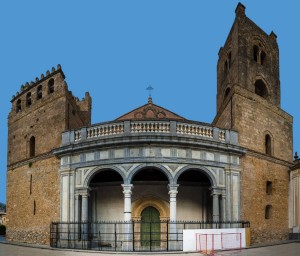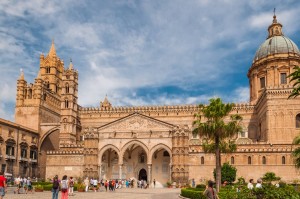
©Bigstock.com/peuceta
Sicily’s history of settlement couldn’t be any more exciting. Various tribes and cultures ruled the island each leaving their very own decisive mark. Excavations and research projects still unearth new evidence of these highly different cultures. Occasionally, they blended with spectacular results. Palermo exemplifies Sicily’s architectural diversity. The mix of Arab, Norman and Byzantine influences is still palpable at the city’s numerous squares. Several churches, castles and a bridge plus the two cathedrals of Monreale and Cefalù were declared UNESCO World Heritage Site in 2015 inviting you to go on a gripping, fascinating round tour.
Sicily’s history of settlement

©Bigstock.com/Frog Dares
As there is a lot to cover in terms of the island’s history of settlement, we skip a few millennia to focus on the matter at hand. The division of the Roman Empire saw the Vandals taking the reins in Sicily before the Ostrogoths assumed power. Emperor Justinian I conquered the island during his endeavours to regain parts of the Western Roman Empire. The rule of the Byzantine Empire would last several centuries. It survived rebellions and a counter-emperor before the Arab conquest of Sicily hit Palermo in 831. Even though the Arabs turned many churches into mosques, they mostly let the Christians follow their own laws. New irrigation techniques brought a massive boost to agriculture.
Even though Sicily gained considerably more autonomy in the years to come, the end of the Muslim Kalbids dynasty saw it disintegrate into smaller principalities. Eventually, the Normans would begin their conquests in the second half of the 11th century taking over Palermo in 1072. However, unlike previous rules, there was no big settlement wave allowing Jews and Muslims to continue to predominantly live in accordance with their own laws. The death of the last Norman King of Sicily in the year 1194 put the kingdom into the hands of the Hohenstaufen dynasty.
Palermo’s castles and the Ponte dell’Ammiraglio
You won’t find any buildings from Arab times today, yet we still talk about an Arab-Norman style. That’s because Arab builders and artists contributed to many different construction projects during Norman rule. As such, their distinctive style is pleasantly visible at many different places, such as Palermo’s two castles. They form the cornerstone of the first part of our UNESCO mini tour that includes a chapel and a bridge.
- Palazzo dei Normanni: The Emir of Palermo had a summer residence built between two river courses in the 9th However, the Norman king ordered the conversion of the Palazzo dei Normanni or Palazzo Reale into a noble seat of rule with many an additional change in the centuries to come. Individual parts of the façade decorated with blind arcades and the Torre Pisana are documents of Norman times while the interior houses Renaissance elements among other styles. Sala dei Venti and Stanza di Ruggero date back to King Roger II.
- Cappella Palatina: The Palazzo’s chapel was also built during the reign of Roger II. Both composition and iconography are based on Roman and Byzantine rites. Experience the pure and unadulterated, close cultural interrelations of the time from the floor decorated with marble and porphyry to the wooden ceiling with Arab wood craft.
- Castello della Zisa: A tall cube acts as an eye-catcher in the royal park. The former summer residence of Norman kings turned home of the Museum of Islamic Art perfects the fusion of Norman and Arab influences. Alcoves with muqarnas on the inside symbolise this clash in an impressive manner.
- Ponte dell’Ammiraglio: The bridge of George of Antioch, a high-ranking court officer of Roger II, originally spanned across a branch of the river Oreto until its exsiccation in 1938. The admiral or ammiratus (hence the name) used a special Arab-Norman technique for the construction process.
The Arab-Norman churches of Palermo
Religious buildings are a major part of this UNESCO World Heritage Site with a whopping four churches in Palermo alone. Time to check out these Arab-Norman highlights!
- Cathedral of Palermo: Today’s cathedral is very far removed from the original building, which was constructed as early as the 6th century, later converted into a mosque and eventually demolished in 1169 after a severe earthquake had caused irreparable damage. The new project kicked off only a few years later with extensions and alterations carried out until the 19th The three apses still reflect the Arab influence while the interior has since been given a new, neoclassical look.
- San Giovanni degli Eremiti: Based on the previous Arab building, elements of the original still adorn the façade. Additionally, the entire classic southern wall survived the times. You’ll see old fresco remains in the sacristy during your trip inside the church. This depiction of the enthroned Mother of God and the remnants of red wall inscriptions have a timeless quality to them.
- Santa Maria dell’Ammiraglio: Remember George of Antioch? He founded this church which now carries his name. Byzantine iconography, Arab carving, Corinthian capitals and Catalan Gothic elements are only some of the many different represented styles. You’ll find something new and fascinating in every corner of this church.
- San Cataldo: Being one of the final churches to be built in the Arab-Norman style, San Cataldo is the perfect end of your Palermo tour. Admiral Majone di Bari had it built as his private church and added stylistic influences from his Apulian home to the classic cube building. Embedded pillars and muqarnas with stepped ogives are characteristic of this era’s style.
The cathedrals of Monreale and Cefalù
The Arab-Norman style also left its mark outside Palermo. Two other cathedrals in neighbouring dioceses are featured in this UNESCO World Heritage Site making up the final part of your trip:
- Cathedral of Monreale: Another example of the final part of this architectural era perfectioned the symbiosis of Norman, Arab and Byzantine elements from the massive structure to the intarsias and blind arches on the outer walls to the famous gold-lead ground mosaics. These Byzantine elements still shine in the brightest lights today and are worth a visit just by themselves. Another highlight is the lavishly designed cloister with 26 ogival arcades and double pillars in highly different shapes. You should be able to see a few more mosaics as part of the inlays.
- Cathedral of Cefalù: Majestic twin towers duly welcome you during your visit. Legend has it that Roger II encountered a severe storm off Sicily’s northern shore and barely managed to reach Cefalù. Out of thankfulness he had this cathedral built, which was even supposed to be his sepulchral church. Byzantine and Norman mosaics, various tombs and sculptures await you inside.
Sicily is always worth a visit with this UNESCO World Heritage Site as yet another excellent reason to finally check out the island! Palermo, Monreale and Cefalù are home to extraordinary architectural fusion. Experience how different styles and eras found one another in a skilful and unique manner. Have fun on this unforgettable round tour!